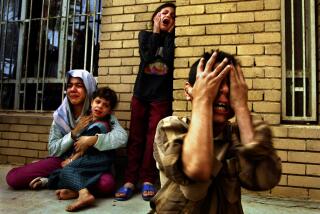Shiites Are Emerging From Fear
- Share via
ANN ARBOR, Mich. — Few religious groups in Iraq were as brutally and lethally repressed by Saddam Hussein’s regime as the Shiites. Although Shiites constitute about 65% of Iraq’s population, the largely Sunni Arab Baath Party had marginalized them politically. The massacres that followed the Shiite rebellion in the spring of 1991 after the Persian Gulf War remain burned in the Shiite’s collective memory. It was not surprising, then, that the capture of Hussein had great emotional resonance among Iraq’s Shiites.
It will take time before Hussein stops haunting Shiite dreams. But if his absence emboldens the Shiite majority, U.S. civil administrator L. Paul Bremer III could face new difficulties as he moves toward the selection of a new Iraqi transitional government. For example, Bremer disregarded the Grand Ayatollah Ali Sistani’s call for one-person, one-vote elections, but with Hussein in captivity and the fear of reprisal gone, Sistani may not back down. There are other indications that Shiites may more aggressively push their agenda.
Good sectarian relations are crucial for Iraq’s future, which is why the difference in the reactions to Hussein’s capture in various parts of the country was worrisome. The Shiites were joyous. In the Kurdish city of Kirkuk, celebrating residents fired rifles with such abandon that they accidentally killed eight bystanders. But the Sunni Arab heartland generally greeted the news sullenly or defiantly. Hundreds of students in Mosul, Tikrit and other towns took to the streets to chant such pro-Hussein slogans as “Bush, Bush, have you noted? It’s to Saddam we are devoted!” Hussein supporters stormed city halls in Ramadi and Tikrit. These kinds of demonstrations may plant the seeds of sectarian warfare in the country, since it is hard to imagine Shiites forgiving this behavior.
Shiites are torn between a desire for revenge and justice. Reports out of the shrine city of Karbala indicate that some citizens favor putting Hussein in a cage and carrying him around the country so that ordinary Iraqis could torture him for the rest of his life. Abdul Aziz Hakim, the Shiite cleric who served as president of the interim Governing Council in December, demanded that Hussein be tried by a tribunal in Iraq. The former Iraqi president killed 63 of Hakim’s relatives.
Although there have been fewer Shiite reprisals against Sunnis than some observers feared before the war, militant Shiites have taken over many Sunni religious properties. The Baghdad coroner’s office told a London newspaper that some 50 former Baath officials were assassinated in mid-to-late December. Many of the dead were known to have killed or repressed Shiites. Others have received threatening notes from a shadowy “Revenge Committee.” The day after Hussein’s capture became public in Baghdad, Shiites from Kazimiya crossed the bridge over the Tigris to gloat in the streets of the largely Sunni Azamiya neighborhood, with which they have an old rivalry. A riot with the Sunnis ensued in which at least 13 were killed. In the Shiite holy city of Najaf, several former Baath officials were killed by gunmen after Hussein’s capture.
Before Hussein’s capture, most Shiites cooperated, if sometimes reluctantly, with the American occupiers. They were said to be fearful that a U.S. military withdrawal might lead to the return of Hussein. With Hussein out of the picture, Shiites who dislike U.S. policies may become more vocal in their opposition.
Shiite-American relations are clouded by the memory of early 1991, when President George H.W. Bush called on Shiites to rise up against Hussein, then stood aside while Hussein’s helicopter gunships slaughtered them. There is substantial discontent with the U.S. occupation in Shiite areas. On Dec. 10, crowds marched in Najaf and Karbala carrying placards calling for an immediate turnover of authority to Iraqis. Although Najaf and Karbala have been relatively moderate politically, Shiites there are increasingly weary of U.S. rule.
Other Shiite currents are virulently anti-American. The firebrand cleric Muqtada Sadr and his vast network of radical mosque preachers in the slums of East Baghdad and elsewhere have repeatedly called for an immediate U.S. withdrawal. They have accused American soldiers of blasphemy and of spreading pornography. They demand an Islamic republic on the Iran model, with clerical rule.
The Sadrists have held many rallies in downtown Baghdad and Basra but have been able to mobilize only 5,000 to 10,000 demonstrators, at most, because many Shiites sympathetic with Muqtada’s cause had stayed away out of fear of Hussein’s return. Muqtada’s reaction to Hussein’s capture was, on the surface at least, conciliatory; he also has moderated his vehemence in recent weeks in response to severe U.S. pressure. He suggested that Dec. 13, when Hussein was captured, be “a day for national reconciliation and to rise up with a free, democratic, independent and unified Iraq.” He added, “It is a shining dawn without Saddam.” Few think Muqtada is really a democrat, but if he again takes his criticism to the streets, it’s likely the ranks of his supporters will swell now that Hussein is in U.S. custody.
Shortly after his capture, Hussein met with four members of the interim Governing Council. He reportedly gestured to Adnan Pachachi, a Sunni, and asked him why he was associating with Shiites. That insult explains why many Shiites are grateful to the U.S. for overthrowing the tyrant. Now that he’s in captivity, they hope the U.S. will lay the groundwork for a Shiite-majority government. If the U.S. disappoints them, it could face a newly assertive Shiite political majority unafraid to engage in mass protests and other forms of resistance.
More to Read
Sign up for Essential California
The most important California stories and recommendations in your inbox every morning.
You may occasionally receive promotional content from the Los Angeles Times.










